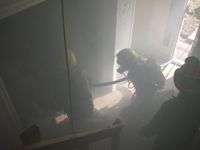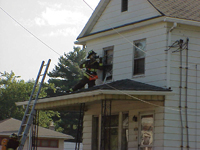
Features
Structural
Training
Back to Basics: A how-to for RIT response
I’m often asked by firefighters when their departments should implement
rapid intervention teams. In my opinion, RITs should be implemented
right away. However, other fire department operational capacities may
hinder this. Let’s look at a few points surrounding implementation the
RIT.
January 6, 2009
By Mark van der Feyst
Running rapid intervention team takes commitment, practice
I’m often asked by firefighters when their departments should implement rapid intervention teams. In my opinion, RITs should be implemented right away. However, other fire department operational capacities may hinder this. Let’s look at a few points surrounding implementation the RIT.
 |
|
| Photo by Mark van der Feyst A rapid intervention team enters a smoke-filled structure during a training exercise. |
Implementation of RIT should be planned
Preplanning for buildings in our municipalities helps us in our fight against fire. We know the layout, utility locations and special hazards ahead of time so that when we get to the building we are prepared. We can apply the same principle to RIT. We can plan out certain target hazards, buildings and events with thought given to where the RIT team will be located, how many teams will be needed, where our main points of entry and exit are and building features that may hinder our ability to act. Preplanning for these variables gives us a step up in the battle should we ever have to deploy the RIT team.
Implementation of RIT should be part of your SOG or SOPs
Make RIT response a standard operating guideline or procedure for your fire department. Ontario Guidance Note 6-11 (35) says every fire department should establish an SOG or SOP detailing RIT operations. It requires that departments put in writing exactly what the RIT team will do, how it will respond, what equipment it will bring, how many fire fighters it will include and who will be in charge. Having all the details in writing makes the job easier to perform. It also ensures that all members of the fire department will share a common goal.
Implementation of RIT should include mutual aid
You will need manpower to conduct RIT operations. Having only two or four people as your RIT will not cut it. Usually the initial RIT making entry will get only to the location of the firefighter before its quarter service air alarm starts going off. If you have all your resources committed to the fire, who are you going to call to supplement the RIT? The obvious answer for smaller departments is to involve mutual aid, and for bigger departments the solution is to additional box alarms. No matter what, you will need fresh bodies to conduct the rescue of a firefighter. Now, imagine having two or three firefighters requiring rescue and you will see how quickly you can use up your resources.
Implementation of RIT should be part of a dispatch protocol
If you preplan your RIT implementation and create an SOG/SOP for RIT, then you should also include a dispatch protocol. This means you will automatically dispatch RIT based upon the type of call to which you are being dispatched. Examples of these types of calls include working structure fires, offensive fire operations and special hazard operations.
Whenever a call is sent out for any of the above situations, an automatic dispatch should be sent to the appropriate agencies for RIT response. This dramatically cuts down the response time of your RIT, as the team will arrive at the scene at the same time as you do. This way, you will have RIT on site right away. If you arrive on scene and you don’t need the RIT, you can always cancel it.
Implementation of RIT should be requested by the first arriving incident commander. If you do not have any formal written policy or any automatic dispatch protocols, then the job of implementing RIT falls on the first-arriving incident commander. This tactical objective is often overlooked because we are concerned with the present situation, usually putting out the fire. However, we also need to address the bigger picture, which includes the RIT. Using a tactical worksheet will help prompt the incident commander to establish an RIT team.
 |
|
| Photo courtesy PSFA The rapid intervention team makes entry after being activated by command during an RIT training exercise. |
Implementation of RIT can involve more than one team
Depending on the size of the incident, the complexity and number of personnel involved, you may need more than one rapid intervention team. This is why it is so important to bring in other resources to augment the RIT operation. Should you need to deploy an RIT, you are guaranteed to use at least 12 to 20 personnel to affect a rescue for one firefighter. The previous points dovetail together to arrive at this point; you may need more than one RIT team, and if you do, how are you going to deal with it?
As mentioned before in the October issue, RIT works only when you have committed the personnel and training to ensure an effective operation. You will want people with an aggressive “can-do” spirit on your RIT because it takes that kind of attitude to rescue downed firefighters. You also want people who can act quickly under poor conditions. The key to implementing your RIT is to have a team that trains together regularly to instill teamwork and proficiency. Make sure you can implement your RIT team right away.
Mark van der Feyst began his career in the fire service in 1998 with the Cranberry Township Volunteer Fire Company, Station 21, in Pennsylvania. He served as a firefighter and training officer for four years, then joined the Mississauga Fire & Emergency Services, where he served for three years as a firefighter and shift medical instructor. He is now the training division captain for the City of Woodstock Fire Department in Ontario.
Print this page